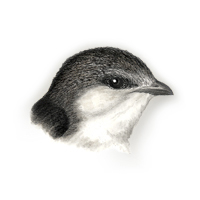 |
White-throated Swift
Aeronautes saxatalis |
|
|
STANFORD LOCATIONS: A number of pairs nest in crevices and cavities under roof tiles and within the eaves of buildings on main campus. Communal roosts begin to form in late summer, and by winter, a flock of 50-100 roosts in or near the Main Quad. These birds forage widely (and high) during the day, but on a winter evening, they can be easily seen circling over the Quad before descending to their roost. |
 |
Location |
Type |
Mating System |
Parental Care |
2ndary Diet |
Strategy |
|
|
|
|
I: ? DAYS ALTRICIAL |
|
|
|
|
(3-6) MONOG? |
MF(?) |
| BREEDING: | Mountainous country near cliffs and canyons, occ coastal sea cliffs. ? broods. |
| DISPLAYS: | Courtship and cop performed in flight; male and female come together from opposite directions, engage, and may tumble slowly downward end over end for as much as 500'. |
| NEST: | Deep in crack or crevice of rock wall, occ in suitable building; of feathers glued together and to rock with saliva. Construction very prolonged. |
| EGGS: | White or creamy white, unmarked. 0.8" (21 mm). |
| DIET: | Flying insects. |
| CONSERVATION: | Winters s through Mexico to Honduras. |
| NOTES: | Nests in small colonies of up to a dozen pairs. Traditional use of nest and roost sites over long time periods. Postbreeding flocks of up to 200 roost together in rock crevices. Able to become torpid during periods of cool temperatures and low food availability. Said to be the fastest of the N.A. swifts. Feet adapted for lateral grasping enable clinging to soft material such as feathers which compose the nest. |
| ESSAYS: | Site Tenacity; Copulation; Temperature Regulation; Communal Roosting. |
| REFERENCES: | Collins, 1983; Dobkin et al., 1986. |
| Help | Abbreviations | Species-Alphabetical | Species-Taxonomic | Essays-Alphabetical | |
| Except for Stanford Locations, the material in this species treatment is taken, with permission, from The Birder's Handbook (Paul Ehrlich, David Dobkin, & Darryl Wheye, Simon & Schuster, NY. 1988). | |||||